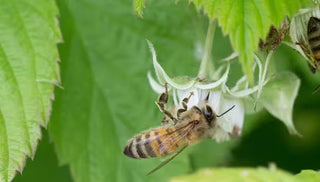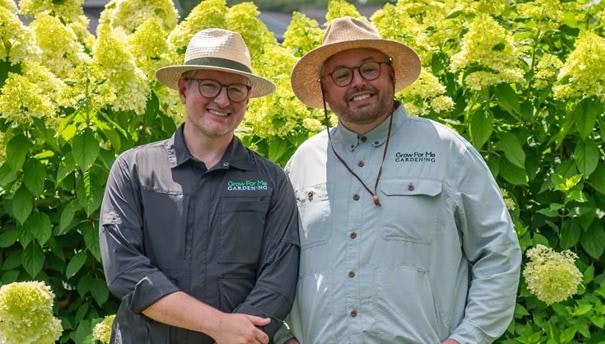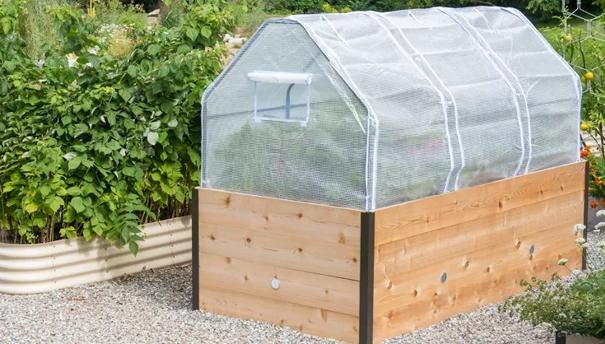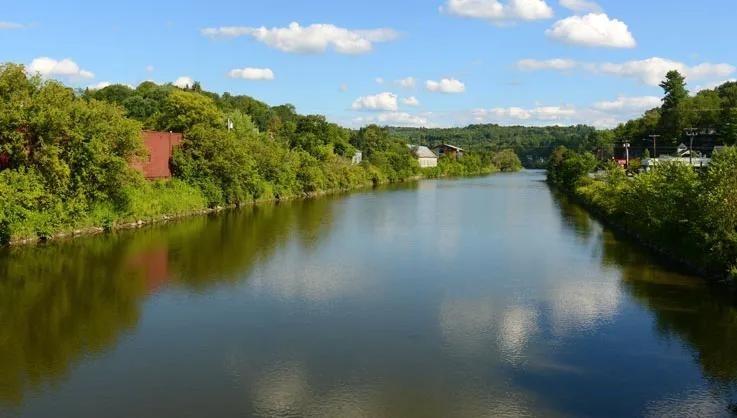 Cranesbill blooms attract a variety of pollinators.
Cranesbill blooms attract a variety of pollinators.1. Plant nectar- and pollen-rich flowers
The most important step you can take is to plant a pollinator-friendly garden. Choose nectar and pollen-rich plants like wildflowers and old-fashioned varieties of flowers. A succession of blooming annuals, perennials and shrubs is best so nectar and pollen will be available throughout the growing season. Also, include plants like dill, fennel and milkweed that butterfly larvae feed on.
Any size garden can attract and support pollinators — from a wildflower meadow to a planter with a few well-chosen species. Researchers in Tucson, AZ, have found that communities of bees can sustain themselves for long periods of time in small vacant city lots.
A patchwork of pollinator gardens in neighborhoods, cities and rural areas around the country could provide enough habitat to restore healthy communities of beneficial insects and pollinators.
2. Go organic
Many pesticides — even organic ones — are toxic to bees and other beneficial organisms. There's no need to use powerful poisons to protect your garden from insects and diseases. In the short term they may provide a quick knock-down to the attackers, but they also kill beneficial organisms. In the long term, you expose yourself, family, pets and wildlife to toxic chemicals, and risk disrupting the natural ecosystem that you and your garden inhabit.
An organic approach is both safer and more effective. By applying the simple principles of ecological plant protection, you can work with nature to control pests and diseases, enjoy a healthier garden and harvest and protect pollinators and other beneficial insects.
If you do apply pesticides make sure you apply them carefully and selectively. To protect pollinators, do not use pesticides on open blossoms or when bees or other pollinators are present.
3. Provide shelter
Butterflies, bees and other pollinators need shelter to hide from predators, get out of the elements and rear their young. Let a hedgerow or part of your lawn grow wild for ground-nesting bees. Let a pile of grass cuttings or a log decompose in a sunny place on the ground. Or, allow a dead tree to stand to create nooks for butterflies and solitary bees.
Artificial nesting boxes can also help increase the population of pollinators in your area. Wooden blocks with the proper-sized holes drilled into them can attract mason bees, as can our selection of other bee habitats. Bat boxes can provide a place for bats to raise their young.
 Butterflies get salts and nutrients from moist soil and puddles.
Butterflies get salts and nutrients from moist soil and puddles.4. Provide food and water
A pollinator garden will provide pollen and nectar. Consider adding special feeders to help attract hummingbirds and butterflies.
Bees, birds and butterflies also all need water. Install a water garden, a bird bath or a catch basin for rain. Butterflies are attracted to muddy puddles which they will flock to for salts and nutrients as well as water.
5. Backyard beekeeping
You don't have to live in the country to keep bees. All you need is a little space, a water source, plenty of nearby flowers for them to visit, and a willingness to learn. Keeping a beehive or two in the backyard used to be a common practice. Maybe it's time to bring back this old-fashioned hobby. It does require equipment and some specific knowledge. But it's nothing an interested hobbyist can't handle. For more information, read Attracting Beneficial Bees.
Plants That Attract Butterflies
Butterflies will certainly take advantage of any nectar sources available, but they are most attracted to blooms that are flat-topped (i.e. zinnias) or clustered with short tubular flowers (i.e. Butterfly weed). Plants with red, orange, yellow, or pink flowers are especially alluring to butterflies.
- Alyssum
- Aster
- Bee balm
- Butterfly weed
- Calendula
- Cosmos
- Delphinium
- Dianthus
- Fennel
- Globe thistle
- Goldenrod
- Lavender
- Liatris
- Marigold
- Musk mallow
- Nasturtium
- Oregano
- Phlox
- Purple coneflower
- Queen Anne's lace
- Sage
- Scabiosa
- Shasta daisy
- Verbena
- Yarrow
- Zinnia
Plants That Attract Caterpillars (Butterfly Larvae)
If you don't feed caterpillars, you'll never see butterflies. It's important to provide a variety of food sources that support butterflies throughout all phases of their life cycle.
- Asters
- Black Oak tree
- Borage
- Chokecherry
- Dill
- Fennel
- Grasses
- Lupine
- Maple-leaf Viburnum
- Milkweed
- Nettle
- Passionflower
- Thistle
- Willow
Plants That Attract Hummingbirds
Hummingbirds are highly attracted to vibrant red, orange, and pink flowers. They use their long tongues to sip nectar out of tubular blooms.
- Agastache
- Bee balm
- Begonia
- Butterfly weed
- Canna
- Cardinal flower
- Century plant
- Columbine
- Coral bells (heuchera)
- Cleome
- Dame's rocket
- Delphinium
- Firecracker plant
- Foxglove
- Fuchsia
- Gilia
- Geranium
- Gladiolus
- Glossy abelia
- Hollyhocks
- Iris
- Lantana
- Liatris
- Lupine
- Nasturtium
- Nicotiana
- Paintbrush
- Penstemon (beardtongue)
- Phlox
- Sage
- Salvia
- Scabiosa
- Scarlet sage
- Sweet William
- Torch Lily
- Verbena
- Yucca
- Zinnia
Plants That Attract Bees
Similar to butterflies, bees also appreciate a flat-topped flower to land on and collect pollen. Flowers with stamen that stand out from the rest of the surrounding petals (i.e. clematis) are easily accessible. Bees cannot see the color red very well, but they can easily detect blues and purples.
- Allium
- Aster
- Basil
- Bee plant
- Borage
- Cherry tree
- Clematis
- Cosmos
- Flax
- Gaillardia
- Geranium
- Giant hyssop
- Globe thistle
- Goldenrod
- Helianthus
- Hyssop
- Joe-pye weed
- Lavender
- Locust tree
- Lupine
- Marjoram
- Mint
- Monarda (wild bergamot)
- Mullein
- Paint brush
- Pear tree
- Plum tree
- Poppy
- Rosemary
- Sage
- Sunflower
- Thyme
- Verbena
- Wallflower
- Wild rose
- Willow
- Yarrow
- Zinnia


 A
A

